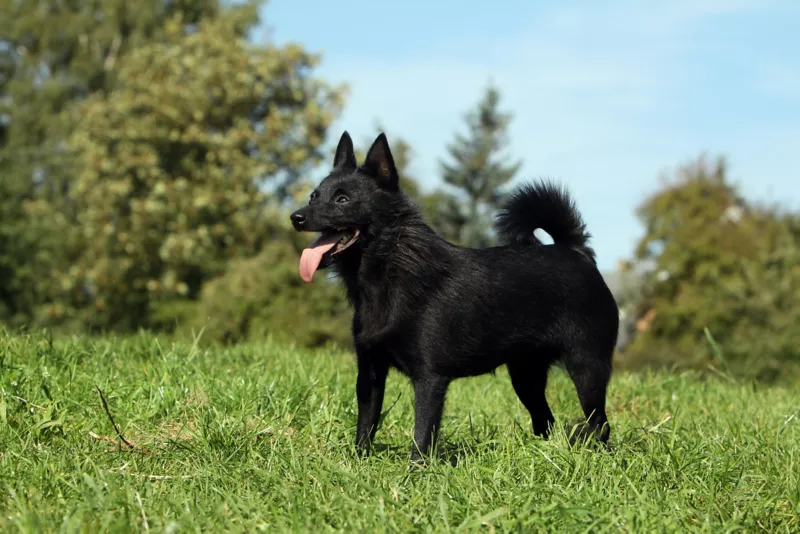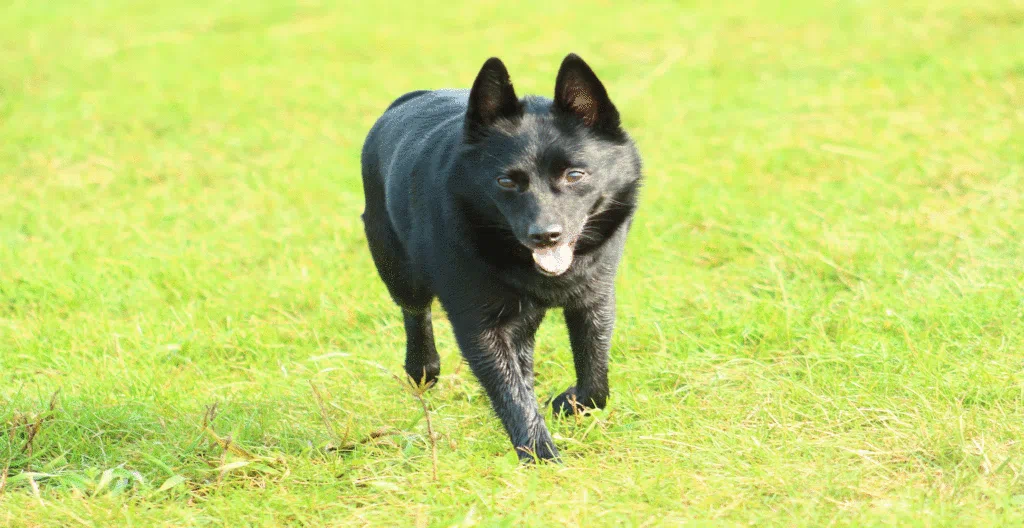
Schipperke (pronunciation: “skip per kee”) dogs are smart, attentive, and trustworthy pets. They are extremely kid-friendly. These small black dogs are also able to get along with other dogs and cats and make excellent family pets. They’re designed to be companions however, they can be feisty companions and have earned the name “Little black devil” because of their raunchy behavior.
Schipperkes are full of enthusiasm and extremely smart, which is why they don’t want to get bored, which is why they’re sure to keep you busy too. If you’re playing with them in the yard or taking them on a thrilling walk, the schipperke is certain to keep you engaged.
The cost of a typical schipperke puppy is about $700, however top breeders’ schipperkes can cost thousands of dollars.
Appearance
Schipperkes are smooth, shiny, black coats with pointed, straight ears and dark eyes. They’re not large dogs The height of an adult typically ranges from 11-13 inches, for males and between 10-12 inches for females. they weigh anywhere from 10 to 18 pounds. Small, but strong, schipperkes were created to be work dogs, and they’ve got sturdy jaws and strong bodies to prove it.
Their beautiful coats are easy to maintain they require brushing regularly, preferably every week. It’s effortless compared to other breeds of small dogs which can require lengthy and costly cleaning routines. The coat of the schipperke is the thickest on the shoulders, neck and legs, providing these dogs a fluffy and full with a sloped, slope.

Schipperke tails are naturally varied in length, ranging from almost invisible and bobbed, to fluffy and long, however, some breeders in the U.S. choose to “dock” or cut the tail shortly after the birth. While this was usual in the past the majority of vets don’t advocate the practice, since it’s not a procedure that’s solely to enhance appearance (and can be quite difficult for the animals!). The schipperke’s appearance is unique that is instantly recognizable: active and smart with fox-like features and sweet smiles.
Temperament
Schipperkes are excellent pets for families who enjoy being with youngsters or cats as well as other dogs. Although they are affectionate and loving to their owners and pets who live together Schipperkes were bred to guard vessels in Belgian canals, and so may not be a fan of strangers or dogs who aren’t familiar with them. As with all dogs, it is essential to engage your schipperke in a timely and appropriate manner because it could be difficult to get together with any other person or pet they’ve not checked.
They are energetic, active, alert, and interested. Because they were initially designed for work aboard boats, they can be intelligent dogs who enjoy working and must be kept mentally engaged. A bored schipperke left to its own devices is bound to find a way to make matters his own jaws or paws by digging, chewing, and barking in order to keep him entertained.
They can be a bit strong-willed and hence the name “Little Black Devil.” Therefore, be sure to have plenty of patience while training. They’re also inclined to wander off to do things on their own, which is why it’s essential to keep an eye (and the leashes) over them.

“Schipperkes aren’t big, but they are powerful dog breeds,” Erin Askeland, CBCC-KA, CPDTK-KA, an animal behavior and health consultant at Bow Wow Camp Bow Wow, says. “Because they’re so nimble and require consistent, solid training and activities It is possible that they could not be the right dog for a new pet proprietor.” If you’re a spirited person but aren’t, schipperkes are great ideal traveling companions.
Living Needs
Since they’re always seeking companions, homes with several pets or people are ideal for Schipperkes. They’re fantastic family dogs however they aren’t a fan of long durations of time left alone. If they are left alone A bored Schipperke may begin making at the back of their yard to escape. In reality, a dog who is bored and finds the environment boring will likely chew, dig and bark endlessly to keep him entertained. Avoid destructive doggie behavior by ensuring plenty of time for time together.
The big yards don’t have to be a requirement for Schipperkes. They can do fine with small, fenced yards or apartments in the event that you allow them plenty of time to roam around the world on a leash. Leashes aside Schipperkes are master escape artists that are prone to escape from open doors or gates to fences. Make sure to keep fences shut and leashes in place to ensure their security.
Schipperkes are loud watchdogs who are determined to save the entire family from danger and some strangers, even when that means barking continuously at delivery people and their neighbors. If you live in an area where noise is a problem the raucous breed may not be the right fit for you.

If you are able to handle the barking it will get plenty of love and fun. The beloved schipperke is extremely low-shedding and low-drool. This makes them ideal for clean-shy owners who prefer to stay clear of sloppy kisses and a lot of filth rolling.
This pet may be sensitive to hot temperatures, so make sure to provide them with plenty of shade and an airy indoor area in warm temperatures.
Care
The coat of the schipperke is usually easy to take care of and requires brushing only every once or twice a week. It may be necessary to brush more often during the shedding time (once or two times per year) to get rid of loose hair. Trim nails frequently, since nails that are too long can cause discomfort.
This breed is extremely energetic and needs intense exercise. They may get exercise in a home or in an apartment, however, taking a walk for a walk is essential. Regular walks or time spent playing in a yard that is fenced will help them get rid of some of their energy. Talk to your vet to find out your dog’s particular fitness needs.
Because they are so vocal These dogs will require training to bark, which isn’t uncommon due to their watchdog character. They might also have to be taught to obey when they are called. This independence is a major challenge but schipperkes are clever dogs that can learn instructions quickly. It is important to be patient, take your time as well as repetition, are among the most effective methods of working.
Schipperkes may be cautious around strangers and dogs that are unfamiliar to them. They must be socialized early. But even after socialization, they may be a bit aloof with pet owners and other dogs that they aren’t familiar with. Allow them to get used to strangers.
“Schipperkes must be exposed to a variety of individuals as well as places and things in order to limit fears-driven responses later on,” Askeland suggests. “Enrolling in a quality puppy’s class of socialization and training classes is a great way to begin and, as they grow older, exposing the puppy to different things throughout their life is recommended.”
Feed your dog high-quality food made of top-quality ingredients. Talk to your vet to find out when and to what amount to feed your pet. Schipperkes are more likely to require their food measured and their diet closely watched due to the fact that they’re susceptible to unhealthy weight growth.
Health

The lifespan of the schipperke is of 13-15 years, and generally healthy.
“Schipperkes typically have good health, however, it is essential for any pet owner to get them thoroughly screened prior to when they can as well as after they acquire one as well as throughout their lifetime to ensure optimal health,” Askeland says. “Ailments that might be affecting a schipperke are the hip joint as well as luxating patellas, thyroid diseases and problems with eyes.”
Breeders with a good reputation will test your puppy for any health concerns, and proactive care can prevent major issues. You can ensure the best care for your pet by keeping regularly scheduled appointments with your vet and following recommendations from your puppy’s health expert.
History
As per the Schipperke Club of America, the breed originated in Belgium and dates back as far as the 16th century. It is believed that they are descendants of the long-gone breed, known as Leauvenaar. Leauvenaar. It is believed that the Leauvenaar was a bigger dog that was bred in size in order to comply with limits on dogs Belgian commoners could have.
Schipperkes were often employed as working dogs who protected the canals’ boats which earned them a fun title: “The Little Captain.” Tradesmen also employed schipperkes early in their roles as “ratters” who would protect mice from rogue and other animals from. In the late 19th century, Queen Marie Henriette of Belgium popularized the schipperke when she was able to take the working breed to be her personal pet.
Fun Facts
Popular schipperke mixes include Australian shepherd-schipperke mix (Aussieschip), Maltese-schipperke mix (schippese), and poodle-schipperke mix (schipperpoo).
Famous people who are fans of the schipperke are comedy star Lucille Ball, and her husband Desi Arnaz.
In World War II, the Belgian Resistance made use of the schipperkes to send secret messages, without notifying the invading Nazis.